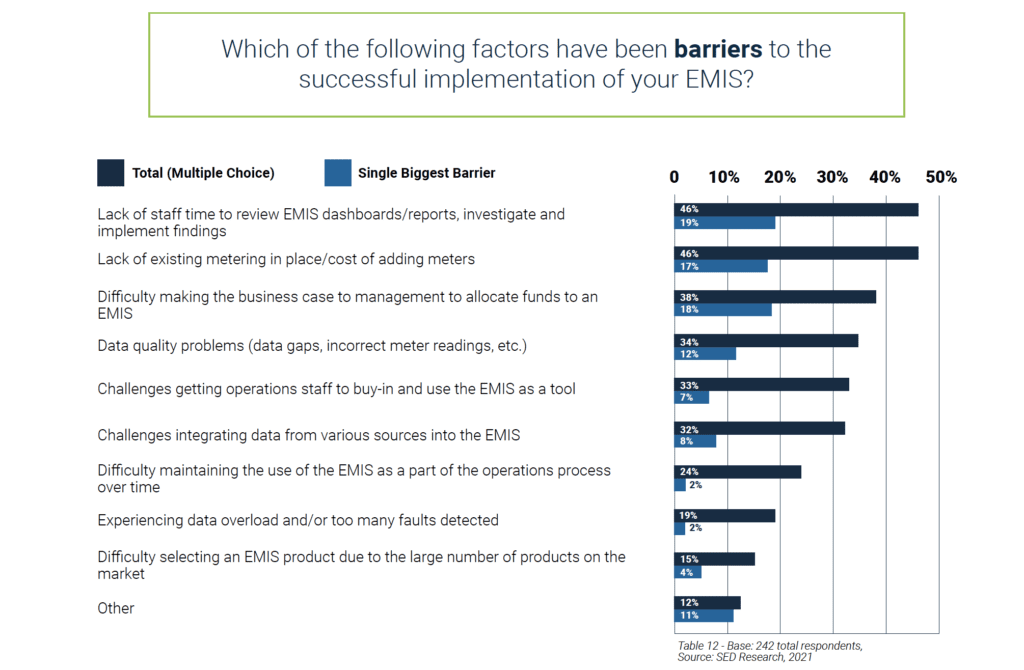Our second annual State of Modern Energy Management report, released January 2021, highlights the practices and expectations of energy and facility managers overseeing building counts from 1-500+ and across six industries. Analyzing the robust information collected, we found several noteworthy takeaways to help industry leaders advance their energy and sustainability goals.
The overarching takeaway from the report is that time and money are still key barriers for energy managers’ decisions and actions. The specific challenge is how too little of both impacts resource reduction, acquisition, EMIS implementation, building performance, and occupancy health management. Encouragingly, industry leaders are advancing along their organizational energy journey, despite these challenges and pandemic-related disruptions.
Top priorities for energy management: reductions and upgrades
Energy and facility managers know reducing energy, water, and waste consumption impacts their fiscal and strategic growth. In fact, 91% prioritized resource reduction last year, and more than half (58%) said their companies are committed to greenhouse gas reduction. These actions, as well as upgrading building automation or IoT infrastructure (52%), can generate higher revenue. Stakeholders recognize this alignment between resource reduction and immediate, tangible cost savings, too.
Energy and facility teams understand the potential ROI from upgrading systems and automating critical processes, but making the business case to upper-management is still challenging. These executives aren’t necessarily ready to spend with it takes to save.
The biggest barriers to success in energy management
The right tools make any job easier, and the tools energy managers want are higher efficiency HVAC (87%), lighting upgrades (79%), and improved access to analytics derived from actionable data (77%). These responses make sense. HVAC is the biggest contributor to overall electricity usage and imperative to meeting revised ASHRAE guidelines for higher IAQ due to the pandemic. More efficient lighting is another big fix to reduce energy consumption. Some energy teams at larger companies already grabbed this “low hanging fruit” by investing in long-lasting LED fixtures. And these leaders might be the same people looking toward upgrading building automation for better access to useful data; to installing an energy management information system (EMIS).
Implementing an EMIS is a proven tactic for continuous optimization and safeguarding occupant health. The platform automates time- and labor-intensive tasks, freeing energy teams to focus on higher-value activities. Unfortunately, lack of time to review findings (19%) and the costs of upgrading or adding new meters (17%) are the major barriers for facility leaders ready to take the next step and install an EMIS.
Teams already using an EMIS still have trouble making time to read the dashboards and adjust operations based on that data. Limited staffing issues trickle into other operational areas, too. Manual data collection is so time-consuming, facility leaders with a small staff can find themselves filling in rather than preparing a business case for EMIS funding. And both situations prevent staff from completing mission-critical tasks that directly impact the bottom line.
Without internal support for EMIS funding, some energy teams have to prove the ROI of existing energy reduction measures just to open EMIS discussions with executive decision-makers. Implementing an EMIS in 2021 means showing how automation moves organizational stakeholders closer to achieving their energy and sustainability goals. And more importantly, to help facility teams meet more stringent IAQ guidelines and local public health regulations, especially as COVID-19 brings continued unknowns.

How COVID-19 will change building occupancy in 2021
Granted, this headline seems so obvious, it’s easy to wonder why say it all. Yes, we know the pandemic changed everything, but it’s the net effect of this disruption that matters to energy and facility leaders.
Managers expect building occupancy to increase by July 2021, even though company administrators are still addressing work-from-home policies and determining what their on-site vs. remote workforces will look like this year. So, energy teams are preparing for fluctuating occupancy and unknown usage levels. And considering both factors affect building performance, industry leaders will have to rapidly—and perhaps frequently—adjust system-wide settings, tracking mechanisms, and maybe even set new energy and sustainability goals. This means even with some staff on-site at varying times, energy managers (40%) anticipate needing the ability to monitor in real-time indoor filtration based on occupancy levels. Responsiveness, adaptability, and automation are 2021 watchwords.
Nimbleness, flexibility, and efficiency are trending with energy and facility managers in 2021. Teams are increasingly automating time-consuming and labor-intensive manual tasks such as meter reading, billing, and utility data collection. They’re harnessing the power of real-time data to improve building operations. And to meet the high demand for resource reduction and stronger bottom lines we discussed earlier.
So, after questioning, pushing, pivoting, and even sometimes guessing our way through 2020, energy leaders, facility managers, and stakeholders can approach this year more informed and confident.
We invite you to go deeper into trends and expectations for 2021 by reading the full State of Energy Management report.




